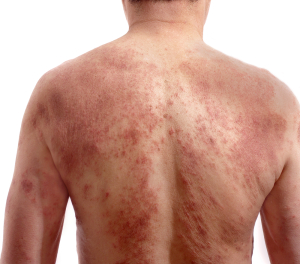Skin diseases are an important sub-section of modern medicine; the sub-specialty that deals with this is called dermatology and the expert in this field is called “dermatologist”. “Skin specialist” is easier to remember and that’s why I called this page “skin diseases” rather than dermatology. So much to clarify some of these name issues.
Introduction
The skin is the largest organ in the body. It has a large surface, which allows it to actively participate in heat exchange with the environment. Water loss through excessive perspiration is an important factor, which needs to be kept in mind with exercising or living in a hot, dry environment. The skin barrier is an important divide between the inside milieu and the outside world. Bacteria, viruses and fungi are largely kept outside and away from the body fluids, where they would otherwise multiply and attack us. A part of the skin are the appendages like hair and nails. Nails give toes and fingers the strength and protection at the end. Head hair is needed for temperature insulation and protection from the ultraviolet rays of the sun.
Dermatology, the specialty of skin diseases, is a large topic of medicine. There are lengthy textbooks written on the topic.
I have concentrated on the more common skin conditions, but would urge you to seek the advice of a physician whenever you see a new skin condition or lesion on your body that was not there before.
Often it is a harmless skin lesion, or a scratch. But the skin lesion could be the first skin cancer symptom or a melanoma symptom, and the scratch may become extremely painful and turn into flesh eating disease. Hair transplantation, once reserved for celebrities only, has become a routine minor surgery performed by professionals and is the only safe and effective way to regain your hair permanently, fully grown and with a natural appearance.
References:
1. Habif: Clinical Dermatology, 3rd ed.,1996, Mosby-Year Book, Inc.
2. The Merck Manual, 7th edition, by M. H. Beers et al., Whitehouse Station, N.J., 1999. Chapter 117.
3. Cotran: Robbins Pathologic Basis of Disease, 6th ed.,1999, W. B. Saunders Company
4. Noble: Textbook of Primary Care Medicine, 3rd ed., 2001, Mosby, Inc.
5. Rakel: Conn’s Current Therapy 2001, 53rd ed., 2001, W. B. Saunders Company
6. Goroll: Primary Care Medicine, 4th ed., 2000, Lippincott Williams & Wilkins
7. Richard J. Lewis, M.D. at the 42nd Annual St. Paul’s Hosp. CME Conf., Nov.1996, Vancouver/BC
8. Jerry Shapiro, Prof. Dermatol., UBC, at 45th Annual St. Paul’s Hosp. CME Conf., Nov.1999, Vancouver/BC
9. D Seager Int J Cosmet Surg Vol 6, No. 1, 1998: 27-31.
10. Townsend: Sabiston Textbook of Surgery, 16th ed.,2000, W. B. Saunders Company







